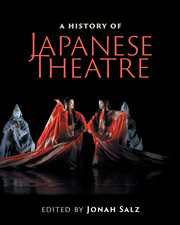Book contents
- Frontmatter
- Contents
- List of figures
- List of tables
- Contributors
- Contributors’ biographies
- Foreword
- Acknowledgments
- Note on Japanese terms
- List of abbreviations
- Timeline
- Editor's introduction
- I Traditional theatres
- Preface to Part I Japanese civilization arises
- II Modern theatres
- Preface to Part II
- 6 Birth of modern theatre: shimpa and shingeki
- Interlude Modern comedies and early musicals
- Interlude Takarazuka: all-girls’ revue and musicals
- 7 Rise of shingeki: Western-style theatre
- Interlude Manzai and Yoshimoto vaudeville comedy
- 8 Wartime colonial and traditional theatre
- Interlude Kami-shibai: picture-card storytelling
- 9 Maturing shingeki theatre
- Interlude Postwar musicals and commercial theatre
- 10 Sixties Theatre
- Interlude Butoh: dance of darkness and light
- 11 Contemporary theatre
- Interlude Tokyo: world theatre capital
- Interlude Charting Tokyo theatre today: 24 November 2012
- Interlude Modern theatre tomorrow: interview with Oriza Hirata
- III Arcs and patterns
- IV Theatre architecture
- Preface to Part IV Evolution of Japanese theatre architecture
- V Theatre criticism
- VI Intercultural influences
- Epilogue: Frozen words and mythology
- Further reading
- Index
- References
10 - Sixties Theatre
from Preface to Part II
Published online by Cambridge University Press: 05 July 2016
- Frontmatter
- Contents
- List of figures
- List of tables
- Contributors
- Contributors’ biographies
- Foreword
- Acknowledgments
- Note on Japanese terms
- List of abbreviations
- Timeline
- Editor's introduction
- I Traditional theatres
- Preface to Part I Japanese civilization arises
- II Modern theatres
- Preface to Part II
- 6 Birth of modern theatre: shimpa and shingeki
- Interlude Modern comedies and early musicals
- Interlude Takarazuka: all-girls’ revue and musicals
- 7 Rise of shingeki: Western-style theatre
- Interlude Manzai and Yoshimoto vaudeville comedy
- 8 Wartime colonial and traditional theatre
- Interlude Kami-shibai: picture-card storytelling
- 9 Maturing shingeki theatre
- Interlude Postwar musicals and commercial theatre
- 10 Sixties Theatre
- Interlude Butoh: dance of darkness and light
- 11 Contemporary theatre
- Interlude Tokyo: world theatre capital
- Interlude Charting Tokyo theatre today: 24 November 2012
- Interlude Modern theatre tomorrow: interview with Oriza Hirata
- III Arcs and patterns
- IV Theatre architecture
- Preface to Part IV Evolution of Japanese theatre architecture
- V Theatre criticism
- VI Intercultural influences
- Epilogue: Frozen words and mythology
- Further reading
- Index
- References
Summary
The prehistory of Sixties Theatre
Definition
“Sixties Theatre” describes a series of movements that arose in the Japanese theatre in the 1960s in opposition to existing shingeki, “modern theatre.” Later these came to be known as the angura (underground) and shōgekijō (little theatre) movements. The main contributing social forces were local political and social upheavals that marked the turning point in postwar Japanese history, and the influence of European rebellions of the “Revolution 68.” The former included large-scale activism against the renewal of the United States—Japan Mutual Security Treaty, coupled with a shift in energy policy from coal to oil despite the coalminers’ determined resistance.
Before Sixties Theatre, shingeki (new theatre) was the preexisting modern Japanese theatre form. Originally modeled on modern European theatre, it was called “new” to distinguish it not only from traditional theatre performance but also from other genres featuring eclectic styles mixing modern Western with premodern Japanese genres, like shimpa. Various factions within Sixties Theatre shared a common ambivalence toward shingeki's methods and values. Mainstream shingeki after World War II was based on realism; Sixties Theatre's anti-realism pursued the censure of modernity. This paradigmatic theatrical shift consisted of three strands: challenging standard realism; searching for independence from the norms of European modernity; questioning rationalistic views of the world and humanity. This chapter will introduce the countervailing vectors leading Japan to forge its own particular experimental theatre from 1960 to 1980, as a reaction against both conservative shingeki and Western logocentricity.
Postwar modern theatre and the critical challenge of Sixties Theatre
The previous chapters showed how imported Western Stanislavskian realism, reinforced by political ideologies, encouraged a social realism that created a mainstream shingeki movement that was earnest, logocentric, and straightforward in its proscenium productions. Sixties Theatre posed multi-front challenges to these existing forms. Rather than faithful depiction of everyday life, it aimed to liberate theatre from imitation.
- Type
- Chapter
- Information
- A History of Japanese Theatre , pp. 289 - 320Publisher: Cambridge University PressPrint publication year: 2016



